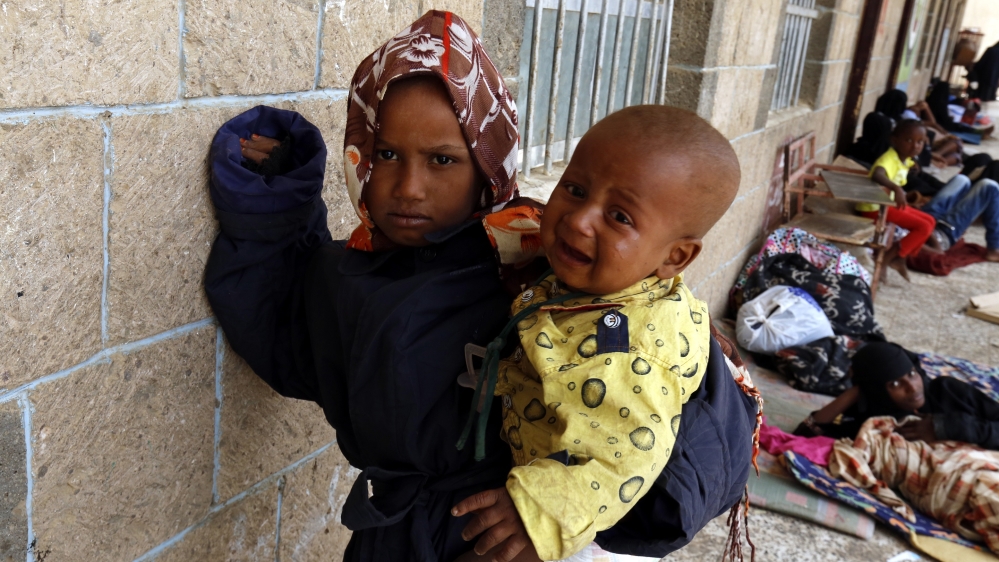One in three young children undernourished or overweight: UNICEF
Report finds 149 million children four or younger are stunted and malnutrition costs the world $3.5 trillion yearly.

A third of the world’s nearly 700 million under five year olds are undernourished or overweight and face lifelong health problems as a consequence, according to a grim United Nations assessment of childhood nutrition released on Tuesday.
“If children eat poorly, they live poorly,” said UNICEF Executive Director Henrietta Fore, as she unveiled the Fund’s first State of the World’s Children report since 1999 to focus on food and nutrition.
Keep reading
list of 4 itemsChildren slide down destroyed Gaza mosque
Why mass kidnappings still plague Nigeria a decade after Chibok abductions
‘Over my dead body’, say Gambian mothers amid efforts to lift FGM ban
“We are losing ground in the fight for healthy diets,” she said.
Problems that once existed at opposite ends of the wealth spectrum have today converged in poor and middle-income countries, the report showed.
|
|
Overall, malnutrition’s cost to the global economy is estimated at $3.5 trillion every year.
Despite a nearly 40 percent drop from 1990 to 2015 of stunting in poor countries, 149 million children aged four or younger are today still too short for their age, a clinical condition that impairs both brain and body development.
In war-torn Yemen, for example, 46 percent of all pre-school children faced stunting based on data from 2013 to 2018.
Yemen was invaded by a Saudi Arabia-led coalition in March 2015. The UN has described the situation in the country as the world’s worst humanitarian crisis.
Meanwhile, another 50 million children around the world are afflicted by wasting, a chronic and debilitating thinness also resulting from poverty.
At the same time, half of youngsters across the globe under five are not getting essential vitamins and minerals, a long-standing problem UNICEF has dubbed “hidden hunger.”
Over the last three decades, however, another form of child malnutrition has surged across the developing world: excess weight.

“This triple burden – undernutrition, a lack of crucial micronutrients, obesity – is increasingly found in the same country, sometimes in the same neighbourhood, and often in the same household,” Victor Aguayo, head of UNICEF’s nutrition programme, told AFP.
“A mother who is overweight or obese can have children who are stunted or wasted.”
Across all age groups, more than 800 million people in the world are constantly hungry and another two billion are eating too much of the wrong foods, driving epidemics of obesity, heart disease and diabetes.
In contrast, the report said that Japan has the lowest rates of infant mortality, while the rate of obesity of children five to 19 is 14.42 percent, which is among the lowest in developed countries.
Experts credit Japan’s school lunches programme and overall healthy diet for its high scores in nutrition.
‘Hidden hunger’
|
|
Among children under five, diet during the first 1,000 days after conception is the foundation for physical health and mental development, the report said.
Only two-in-five babies are exclusively breastfed for their first six months, as recommended by global health guidelines.
Sales of milk-based bottle formulas have risen worldwide by 40 percent, and in upper middle-income countries such as Brazil, China and Turkey by nearly three-quarters.
Missing vitamins and minerals, meanwhile, can lead to compromised immune systems, poor sight and hearing defects.
A lack of iron can cause anaemia and reduced IQ.
“It’s ‘hidden’ because you don’t notice the impact until it is too late,” Brian Keeley, editor-in-chief of the report, told the AFP news agency.
The rise of obesity, however, is plain to see.
The problem was virtually non-existent in poor countries 30 years ago, but today at least 10 percent of under fives are overweight or obese in three-quarters of low-income nations.

“There needs to be a focus on obesity before it is too late,” said Keeley. “Unless you deal with it in a preventative way, you’re going to struggle to fix it later on.”
UNICEF said that the United States tops the percentage of obesity of children aged five to 19 with 41.86 percent, with Italy at 36.87 percent and France at 30.09 percent. Japan has the lowest rate in that category at 14.42 percent.
Climate change factor
Progress in fighting undernourishment will also be hampered by climate change, the report warned.
|
|
A single degree Celsius of warming since the late-19th century has amplified droughts responsible for more than 80 percent of damage and losses in agriculture.
The Earth’s average surface temperature is set to rise another two or three degrees by 2100.
Research by scientists at Harvard University, meanwhile, has shown that the increased concentration of CO2 in the air is sapping staple food crops of essential nutrients and vitamins, including zinc, iron and vitamin B.
“The impacts of climate change are completely transforming the food that is available and that can be consumed,” Aguayo said.
Making sure every child has access to a healthy diet must become a “political priority” if widespread malnutrition is to be conquered, especially in developing countries, the report said.